Hi Ti Team,
DRV8306HRSMR芯片的nFault故障信号引脚在开机的时候,有一个异常的低脉冲,约770us,请帮忙给些建议,谢谢
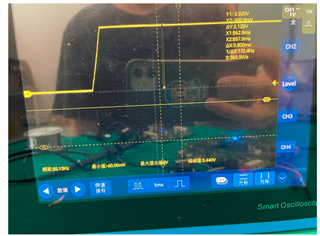
This thread has been locked.
If you have a related question, please click the "Ask a related question" button in the top right corner. The newly created question will be automatically linked to this question.
Hi Ken,
We are looking into this for you.
Can you help share your schematic, and some more information about your system?
From the DRV8306 datasheet, here is the fault response table for the different type of fault events.
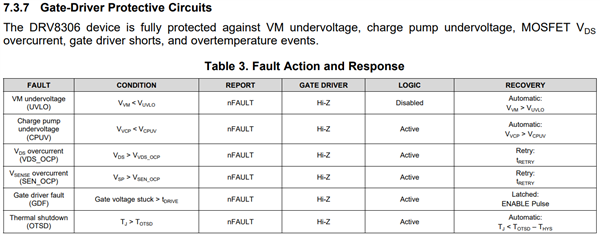
Thanks and Best Regards,
Andrew
Hi Ken,
Can you also share a voltage waveform oscilloscope capture of nFAULT, VM, and ENABLE pins on the same screen?
We think that this might be a normal nFAULT pin pulse signal for initial device power-up, but will need more info on the other pins to confirm.
Please help collect and share this scope capture data if possible.
Thanks and Best Regards,
Andrew
This is the waveform of the nFault Vm and ENABLE,and my company email :luyuqiang@pudutech.com
I hope you can send the information to my email address;
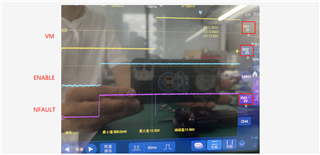 ...
...
About the HALL sensors,Input 3.3V square wave to the HPB pin ,that voltage of the waveform detected on the HPB is 3.3V, In the HPC pin input the same square wave as the HPB pin, just a 2.8V waveform was detected on HPC;
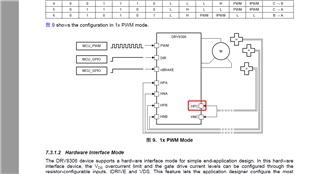
Hi Yuqiang,
Thanks for sharing this waveform with us - it really helps.
From looking at the waveform of all 3 signals, we see that your nFAULT low-pulse occurs at around the same time as VM power-up.
We think that the observed nFAULT low pulse is not a problem, and here is the reason why:
1) At initial device power-up, the nFAULT pin will transition from high-to-low since VM and the charge-pump are not yet powered on completely. This is the device's UVLO protection.
2) Once fully powered on, the nFAULT pin recovers from low to high automatically, indicating that the device is ready-to use. (UVLO fault condition is cleared).
If your motor driver system is able to drive the motor successfully after power-up, then this temporary nFAULT low pulse is expected and normal.
Image of datasheet reference to charge-pump UVLO:

Please let me know if this helps answer your question, and if there are any further concerns.
Thanks and Best Regards,
Andrew
Your consciousness this malfunction signal does not affect function? Since we are about to put this product into production, we want to minimize the risk.
When we conduct short circuit test, the following two cases are listed:
1. After shorting pin SHA and pin SHB, the motor starts to run;
2, in the process of motor operation, short pin SHA and pin SHB;
In the above two cases, the rising time of the current exceeds 5us, reaching 5.6us;
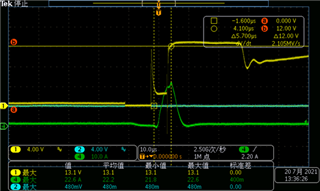
About the HALL sensors,Input 3.3V square wave to the HPB pin ,that voltage of the waveform detected on the HPB is 3.3V, In the HPC pin input the same square wave as the HPB pin, just a 2.8V waveform was detected on HPC;

Hi Yuqiang,
Thanks for your response -
let me discuss this further with our team and I will try to get you a follow-up answer before the end of this week.
Also noted on the hall sensor question, and will bring it up during the discussion.
Thanks and Best Regards,
Andrew
Hi Yuqiang,
Thanks for your patience - please see latest responses below:
Thanks and Best Regards,
Andrew
Hi,I would like to clarify a problem about DRV8306HRSMR chip.
In the short-circuit test, phase A and phase C are short-circuitated together, and then the motor starts to run.
The chip detects that the external MOSFET drive has overcurrent and short circuit.
The protection time is up to 11.12ms, and the maximum current is 21.1A.
I would like to know if there is any damage to the external MOSFET and motor.
Here is the waveform of the test:
你好,我想弄清楚一个问题,就是关于这个驱动芯片DRV8306HRSMR
我们进行多项短路测试,其中有一项,将A相与C相短路在一起之后,电机开始运转
驱动芯片识别到外部MOSFET出现过流以及短路的现象,进行短路保护,其短路保护时间最大为11.12ms,最大电流为21.1A;
我想知道这么长时间的短路保护会不会对电机以及外部的MOSFET有影响;
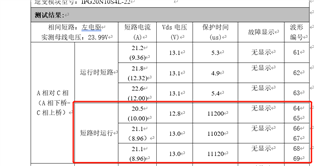
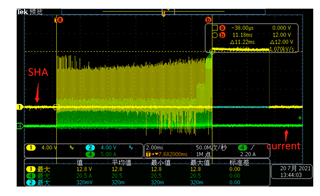
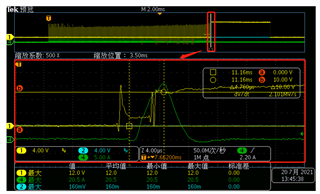
Hi Yuqiang,
We are looking into this and will follow up with a response.
(most likely need a few days to align with the team)
Will let you know if I need any more information
Thanks and Best Regards,
Andrew
Hi Yuqiang,
We are still looking into this and should be able to get you a response within the next day or two
Best Regards,
Andrew
Hi Yuqiang,
Please see the updated response below to your questions:
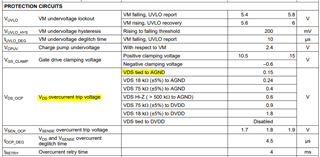
Thanks and Best Regards,
Andrew
Thank you very much for your help. If there is any question about the short-circuit test, I will communicate with you later. Thank you